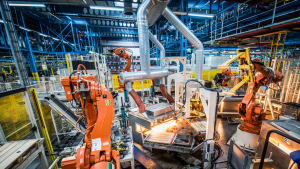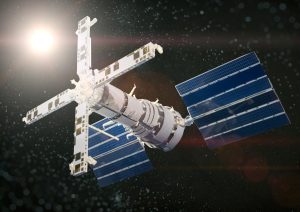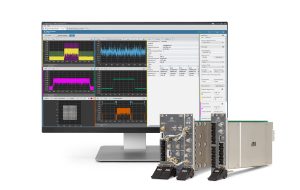Solving the Issue of Reflected Waves at D Band
Looking to deliver reliable test, measurement, and prototyping equipment for D band led NI to THz-enabled isolators designed for NASA.
The call for “more D band” has gone out. With the ability to transmit 100 Gigabits per second (Gbps), the D band will unlock several technologies across various industries. Wireless communication is often the focal point, but commercial applications include high-precision sensing, radio astronomy, and airport security detectors. For the military, the D band will open the door to the next generation of inter-satellite links, imaging radars, and stand-off detection.
However, as research and development teams attempt to deliver on the much-anticipated move into the frequency range between 110-170 GHz, they are running into a common problem of signal reflections, also known as mismatches. These undesirable waves, or ripples, can attenuate power output, distort the digital information on the carrier, and, in extreme cases, damage internal components.
Engineers rely on Faraday rotation isolators to offset the issue of mismatches at lower microwave frequencies. However, traditional isolators, like those within the D band, often struggle to deliver the same results at higher frequencies.
“When you get above 110 GHz, it’s sort of uncharted territory,” explains Ed Loewenstein, Chief Architect at NI. “Your connectivity gets strange, and cables no longer work well. So, most things are done in waveguides.”
Suppressing signal reflections
Only recently, limited test and measurement equipment has been available at D band frequencies, with few standards and little-to-no traceability to NIST (National Institute of Standards and Technology).
“What we often hear is that once someone sets up their equipment to make a test or measurement at these frequencies and something doesn’t go quite right, they spend most of their time trying to figure out whether it’s their test equipment or the device that they’re testing,” adds Loewenstein.

Therefore, developing the D band depends on companies like NI, formerly National Instruments, which create the equipment engineers rely upon to efficiently and accurately perform comprehensive research, testing, and validation. However, recently, as the company was looking to create a new 6G sub-THz reference architecture, they ran into the issue of reflected waves themselves in the waveguides.
“We were struggling with bad mismatches in our waveguide system and kept getting these bad frequency ripples,” adds Loewenstein.
In millimeter wave (mmW) systems, the distance between components is often much larger than a wavelength. As you sweep frequencies, the phase changes, nulls, dips, and degraded performance. Engineers insert an isolator between components to resolve that in microwave frequencies, and the reflected signal gets absorbed.
However, shorter wavelengths require smaller constituent parts as you move up the electromagnetic spectrum. At mmW frequencies, the details are tiny, and even the slightest misalignment can significantly degrade performance.
As demand for D band systems increases, so does the number of isolator options available. Unfortunately, their performance still lags what engineers are accustomed to at lower frequencies.
Advances in mmW isolator design
“We evaluated the isolators on the market from what data was available, and it was pretty easy arithmetic to see that Micro Harmonics was the most appropriate thing for us,” adds Lowenstein.
Micro Harmonics Corporation is a Virginia-based manufacturer specializing in the design of mmW components. Under a NASA contract, Micro Harmonics reinvented the isolator to operate well into THz frequencies.
The traditional method to manufacture an isolator has been to use ferrites that are substantially longer than required and then tune the magnetic bias field to achieve optimal performance. This delivers sound isolation but at a much higher insertion loss.
What Micro Harmonics did to minimize loss was reduce the ferrite length by as much as possible. The design developed for NASA saturates the ferrite with a solid magnetic bias field, allowing the shortest possible distance to achieve the ideal 45° of rotation. This lowers the insertion loss to less than 1 dB at 75-110 GHz and only 2 dB at 220-330 GHz.
The only way to confirm such precision is to characterize each isolator on a vector network analyzer fully. This validates total compliance instead of just spot-checking at a couple of frequencies in the band. The test data are then supplied with each isolator.
“They are one of the vendors that we’ve encountered that supplies full S-parameter files, which include magnitude and phase,” says Lowenstein. “When dealing with a high-value component, whose performance you are counting on, I would say this type of information is essential.”
Meeting deadlines for D band
NI needed to deliver its new mmW test and measurement equipment and advanced software-defined radios, which can accelerate prototyping and next-gen wireless innovation.
Loewenstein says it was important that the isolator could cover the entire D band, which the isolators designed for NASA could do.
“It was a nice bonus that it is designed in a small cube, so it fits directly onto a flush surface without a rear accessible flange, explains Loewenstein. “You don’t need extra waveguide sections or anything.”
NI measured their systems before and after inserting the isolator and saw a noticeable improvement in the ripple, which they said was due to cleaning up the mismatch reflections. This allowed them to announce the 6G Sub-THz reference architecture that provides calibrated measurements with up to four gigahertz modulation bandwidth.
“We can now receive and transmit at D band. We can also use software-defined radio techniques to prototype and make traceable measurements to a power meter,” says Loewenstein.

The insatiable demand for data bandwidth, especially for communications, and the existing spectrum available within the D band have companies charging ahead at lightspeeds. As part of that allure, the FCC recently allowed some experimental licenses in the D band and up to 220 gigahertz so that people can develop new broadband communication methods that use those frequencies.
“Right now, people are looking to do research in sub-terahertz communication. They are designing future chipsets, radio links, or the protocols,” explains Loewenstein. “So, we are looking to allow them to make tests and measurements and utilize our software-defined radios to enable future growth within the D band and beyond.”


